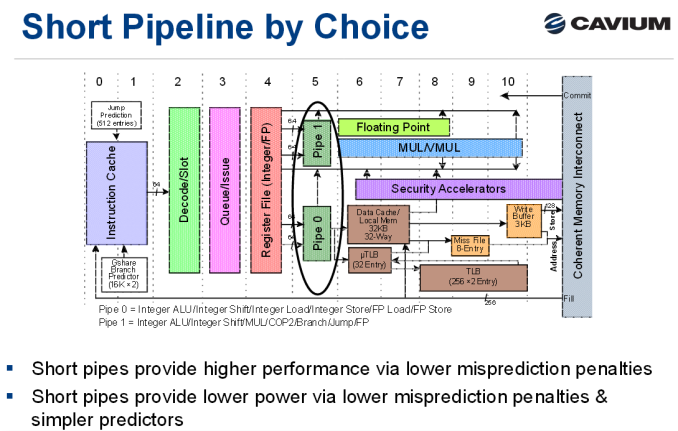Investigating Cavium's ThunderX: The First ARM Server SoC With Ambition
by Johan De Gelas on June 15, 2016 8:00 AM EST- Posted in
- SoCs
- IT Computing
- Enterprise
- Enterprise CPUs
- Microserver
- Cavium
The Small Cavium ARM Core
Cavium has not talked much about ThunderX's internals. But since the launch of the Octeon back in 2006, Cavium has continued to build further upon this microarchitecture. Given the similarities in specifications and what we have read and heard so far about the ThunderX, it is safe to assume that the internal architecture of ThunderX is an improved version of the Octeon III.
The Cavium core can probably only sustain 2 instructions per clock, with a very simple 4 issue back-end. To put this in perspective: Intel's latest "Broadwell/Skylake" designs can sustain 5-6 instructions per clock and issue up to 8 integer instructions (load/store included). While we are not sure whether there have not been significant changes to the backend, the basic pipeline has remained the same (9 cycles instead of 8). That means that the design might do well in branch intensive low IPC situations, which are very common in lots of server applications. But the consequence is also that it is very unlikely that the Cavium will be able to reach the turbo speeds that the Xeons reach (3.5 GHz and more).
To that end we'll test this in great detail: is the Cavium ThunderX core more like an ARM Cortex-A53, or is it a bit more muscular?











82 Comments
View All Comments
JohanAnandtech - Wednesday, June 15, 2016 - link
Good suggestion. I have been using an ipmi client to manage several other servers, like the IBM servers. However, such a GUI client is still a bit more userfriendly, ipmi commands can get complicated if you don't use them regularly. The thing is that HP and Intel's BMC GUI are a lot easier to use and more reliable.fanofanand - Wednesday, June 15, 2016 - link
I think you may have an inaccurate figure of 141 at idle (in the graph) for the Thunder. "makes us suspect that the chip is consuming between 40 and 50W at idle, as measured at the wall"JohanAnandtech - Wednesday, June 15, 2016 - link
If you look at the Column "peak vs idle", you see 82W. At peak, we assume that a 120W TDP chip will probably need about 130W. 130W - 82W (both measured at the wall) = 50W for the SoC alone at idle measured at the wall, so anywhere between 40-50W in reality. My Calculation is a "guestimate", but it is clear that the Cavium chip needs much more in idle than the Intel chips.(10-15W) .djayjp - Wednesday, June 15, 2016 - link
Many spelling/grammar issues here. It impacts readability. Please read before posting.djayjp - Wednesday, June 15, 2016 - link
That is to say in the article.mariush - Wednesday, June 15, 2016 - link
These guys are already working on ThunderX2 (54 cores, 3 Ghz , 14nm , ARMv8) and they already have functional chips : https://www.youtube.com/watch?v=ei9uVskwPNEMeteor2 - Thursday, June 16, 2016 - link
It's always jam tomorrow, isn't it? Intel is working on new chips too, you know.beginner99 - Wednesday, June 15, 2016 - link
It loses very clearly in performance/watt to Xeon-D. In this segment the lower price doesn't matter in that case and the fact that it has a process disadvantage doesn't matter either. What counts is the end result. And I doubt it would cost $800 if made on 14/16nm. I mean why would anyone buying this take the risk? Safer bet to go with Intel also due to more flexible use (single and multi threaded). The latency issue is mentioned but downplayed.blaktron - Wednesday, June 15, 2016 - link
So downplayed. Anandtech desperately wants ARM servers, but its a solution looking for a problem. Big web front ends running on bare metal are such a small percentage of the server market that developing for it seems stupid. Xeon-D was already in development for SANs, they just repurposed it for docker and nginx.Senti - Wednesday, June 15, 2016 - link
Very nice article. I especially liked the emphasis on relations of test numbers and real world workloads and what was problematic during the testing.It would be great to see the same style desktop CPU review (Zen?) form you instead of mix of reprinted marketing hype with silly benchmark numbers dump that plagues this site for quite some time now.
Some annoying typos here and there, like "It is clear that the ThunderX is a match for high frequency trading", but nothing really bad.